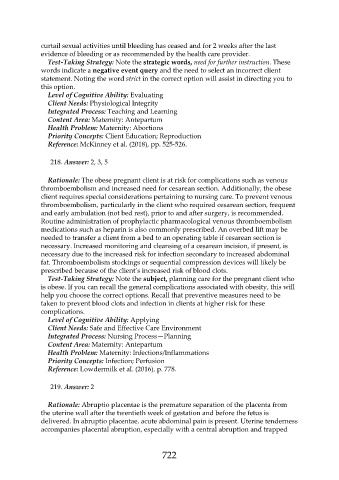Page 722 - Saunders Comprehensive Review For NCLEX-RN
P. 722
curtail sexual activities until bleeding has ceased and for 2 weeks after the last
evidence of bleeding or as recommended by the health care provider.
Test-Taking Strategy: Note the strategic words, need for further instruction. These
words indicate a negative event query and the need to select an incorrect client
statement. Noting the word strict in the correct option will assist in directing you to
this option.
Level of Cognitive Ability: Evaluating
Client Needs: Physiological Integrity
Integrated Process: Teaching and Learning
Content Area: Maternity: Antepartum
Health Problem: Maternity: Abortions
Priority Concepts: Client Education; Reproduction
Reference: McKinney et al. (2018), pp. 525-526.
218. Answer: 2, 3, 5
Rationale: The obese pregnant client is at risk for complications such as venous
thromboembolism and increased need for cesarean section. Additionally, the obese
client requires special considerations pertaining to nursing care. To prevent venous
thromboembolism, particularly in the client who required cesarean section, frequent
and early ambulation (not bed rest), prior to and after surgery, is recommended.
Routine administration of prophylactic pharmacological venous thromboembolism
medications such as heparin is also commonly prescribed. An overbed lift may be
needed to transfer a client from a bed to an operating table if cesarean section is
necessary. Increased monitoring and cleansing of a cesarean incision, if present, is
necessary due to the increased risk for infection secondary to increased abdominal
fat. Thromboembolism stockings or sequential compression devices will likely be
prescribed because of the client’s increased risk of blood clots.
Test-Taking Strategy: Note the subject, planning care for the pregnant client who
is obese. If you can recall the general complications associated with obesity, this will
help you choose the correct options. Recall that preventive measures need to be
taken to prevent blood clots and infection in clients at higher risk for these
complications.
Level of Cognitive Ability: Applying
Client Needs: Safe and Effective Care Environment
Integrated Process: Nursing Process—Planning
Content Area: Maternity: Antepartum
Health Problem: Maternity: Infections/Inflammations
Priority Concepts: Infection; Perfusion
Reference: Lowdermilk et al. (2016), p. 778.
219. Answer: 2
Rationale: Abruptio placentae is the premature separation of the placenta from
the uterine wall after the twentieth week of gestation and before the fetus is
delivered. In abruptio placentae, acute abdominal pain is present. Uterine tenderness
accompanies placental abruption, especially with a central abruption and trapped
722

